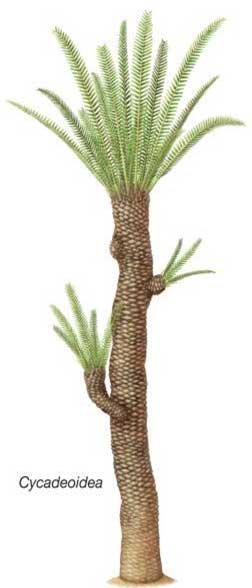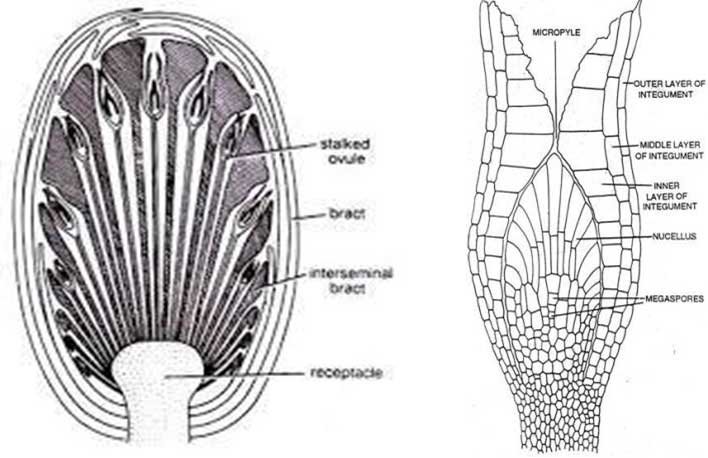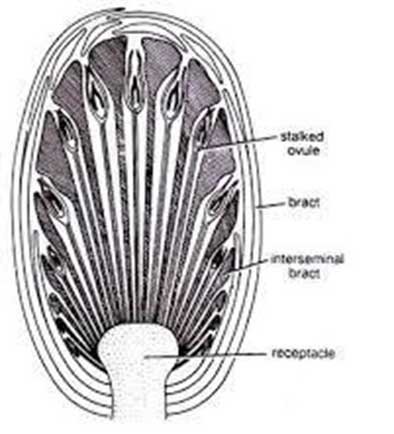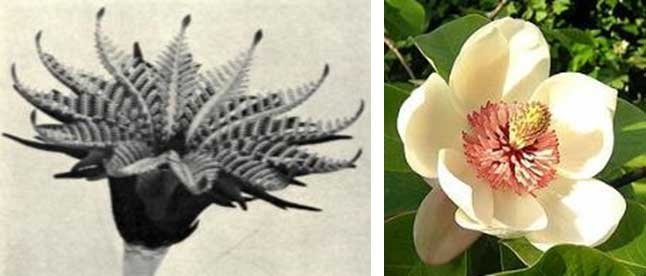Cycadeoideales (Bennettitales) were an extinct group of seed plants that flourished during the Mesozoic era, especially from the Triassic to mid-Cretaceous periods. They resembled modern cycads in having stout, unbranched stems and a crown of pinnate leaves. Their reproductive structures were unique, flower-like strobili, often bisexual and borne in the axils of leaves. Cycadeoideales show affinities with Cycadales, Pteridospermales, and primitive Angiosperms based on features like motile gametes, compound microsporophylls, and their floral organization. This article discusses the general characters of Cycadeoideales (Bennettitales) with their distribution, examples and affinities.
Overview of Cycadeoideales (Bennettitales)
Ø Cycadeoideales are also known as Bennettitales.
Ø They represent an extinct group of fossil plants.

Ø Cycadeoideales first appeared during the Permian or Triassic periods.
Ø They flourished during the Triassic to mid-Cretaceous periods.
Ø They exhibit superficial resemblance to modern cycads.
Ø The trunk of Cycadeoideales is short and stumpy, similar to cycads.
Ø The leaves form an apical crown, resembling cycads.
Ø Despite similarities, they show distinct differences from cycads.

Examples of Cycadeoideales (Bennettitales)
Ø Reconstructed genera include Cycadeoidea and Williamsonia.
Ø The genus Cycadeoidea is known for its stem structure.
Ø Williamsonia is known for having a stem with leaves.
Ø Wielandiella is characterized by branched structures with strobili.
Ø The genus Bennettites represents the mature female part of the strobili.

Cycadeoideales (Bennettitales) General Characters
Stem
Ø The stem is upright and columnar in shape.
Ø The typical height of the stem is around one meter.
Ø The growth rate of the stem is slow.
Ø The stem is usually branched.
Ø In Cycadeoidea, the stem is short and barrel-shaped with a crown of leaves.
Ø The stem contains a large central pith surrounded by vascular bundles.
Ø The vascular bundles are conjoint, collateral, and open.
Ø The cortex is parenchymatous and contains numerous mucilaginous canals.
Ø Leaf traces arise directly from the stem, without forming girdle traces.

Leaves
Ø The leaves are large and pinnately compound.
Ø Xerophytic adaptations are present in the leaves.
Ø In Williamsoniella, the leaves are simple.
Ø The pinnae are arranged laterally along the rachis.
Ø In Williamsonia, the pinnae are attached to the upper surface of the rachis.
Ø Venation is unicostate and parallel in most forms.
Ø In Dictyozamites, the venation is reticulate.
Ø Stomata are syndetocheilic.
Ø Ramental hairs are present in some species.
Ø Ramenta are multicellular, flattened, and scale-like, unlike the unicellular ramenta of Cycas.

Reproductive Structures in Cycadeoideales (Bennettitales)
Ø The reproductive structures resemble flowers and are referred to as strobili.
Ø These ‘flowers’ appear in the axils of the leaves.
Ø Most plants were bisexual (monoecious), though some, like Wielandiella angustifolia, were unisexual.
Ø The strobili are typically bisporangiate.
Ø This bisporangiate condition distinguishes them from other gymnosperms.
Ø The stamens mature before the gynoecium, facilitating cross-pollination.

Ø Many Cycadeoideales likely flowered once and died, similar to certain present-day angiosperms.
Ø In some species, strobili are unisexual.
Ø The strobilus consists of a central ovuliferous receptacle surrounded by stamens (microsporophylls).
Ø The receptacle may be flattened, dome-shaped, or conical in structure.
Ø Inter-seminal scales are present on the receptacle.
Ø Ovules and seeds are distributed among these scales.
Ø Numerous hairy bracts surround the entire flower-like structure.
Ø Bracts arise from the base of the receptacle.
Ø Microsporophylls arise in whorls, typically 10 or 20 in number.
Ø All microsporophylls are fused at the base.
Ø Each microsporophyll bears about 20 slender pinnae on either side.
Ø Sporangia develop in two rows on the underside of the pinnae.
Ø The sporangia are fused to form a synangium.
Ø Young microsporophylls are rolled inward, resembling fern leaves.
Ø Male gametes are motile.
Ø The central part of the flower is the receptacle, bearing orthotropous ovules.
Ø Ovules are stalked in Cycadeoidea and Williamsonia.
Ø In Williamsoniella, the ovules are sessile.

Ø The ovular integument has three distinct layers, similar to Cycas.
Ø An ovular cupule may be present or absent.
Ø Seeds are dicotyledonous, possessing two cotyledons.
Affinities of Cycadeoidales (Bennettitales)
Affinities with Cycadales
Similarities
Ø Both groups exhibit similar external morphology and growth habit.
Ø Manoxylic wood is present in both.
Ø Pollen grains are monocolpate in both groups.
Ø Both possess motile male gametes.
Ø Ovules are orthotropous in both.
Ø The ovular integument is differentiated into three layers in both.
Ø Embryos are dicotyledonous in both groups.
Differences
Ø Stomata are haplocheilic in cycads but syndetocheilic in Cycadeoideales.
Ø Leaf traces form girdles in cycads but are direct in Cycadeoideales.
Ø Cycads produce monosporangiate cones, whereas Cycadeoideales are bisporangiate.
Ø Microsporophylls are spirally arranged in cycads but occur in whorls in Cycadeoideales.
Ø Ovules are arranged on the margins of megasporophylls in cycads, but on a thalamus or receptacle in Cycadeoideales.
Affinities with Pteridospermales
Similarities
Ø Both groups have ramental hairs.
Ø The internal anatomical structures are similar.
Ø Stomata are syndetocheilic in both groups.
Ø Leaf traces are direct in both.

Ø Leafy microsporophylls bearing sporangia occur in both.
Ø Ovular cupules are present in some members of both groups.
Differences
Ø Cycadeoideales possess bisexual ‘flowers’, whereas Pteridospermales do not.
Ø Ovule arrangement is different between the two groups.
Ø Ovular integuments in Cycadeoideales possess vascular supply, which is absent in Pteridospermales.
Affinities with Angiosperms
Similarities
Ø Flower-like reproductive structures are present in both.
Ø Bisporangiate strobili are seen in both.
Ø The flower structure resembles primitive angiosperm flowers such as those of Ranales and Magnoliales, with spirally arranged floral parts.
Ø Bessey and Hutchinson proposed that angiosperms may have evolved from Mesozoic Cycadeoideales.
Ø The bracts in Cycadeoideales are comparable to the perianth in angiosperms.

Ø The homoxylous wood of Cycadeoideales resembles the vessel-less wood of primitive angiosperms like Drimys, Trochodendron, and Tetracentron.
Differences
Ø Ovules are naked in Cycadeoideales, unlike in angiosperms.
Ø Cycadeoideales do not form true fruits.
Ø Compound stamens with synangia are found in Cycadeoideales.
Ø Most angiosperms have haplocheilic stomata, unlike the syndetocheilic stomata in Cycadeoideales.
Ø Male gametes are motile in Cycadeoideales.
Ø Cycadeoideales lack triple fusion and double fertilization.
Ø It is now believed that angiosperms and Cycadeoideales exhibit parallel evolution, having independently developed similar traits due to comparable selective pressures.
I hope you found this article on Cycadeoideales is informative and beneficial. Your feedback and comments would be greatly appreciated. Whether you have suggestions, questions, or thoughts to share, I would be delighted to hear from you. Thank you for your support.
Regards: Admin, EasyBiologyClass
| You may also like NOTES in... | ||
|---|---|---|
| BOTANY | BIOCHEMISTRY | MOL. BIOLOGY |
| ZOOLOGY | MICROBIOLOGY | BIOSTATISTICS |
| ECOLOGY | IMMUNOLOGY | BIOTECHNOLOGY |
| GENETICS | EMBRYOLOGY | PHYSIOLOGY |
| EVOLUTION | BIOPHYSICS | BIOINFORMATICS |
